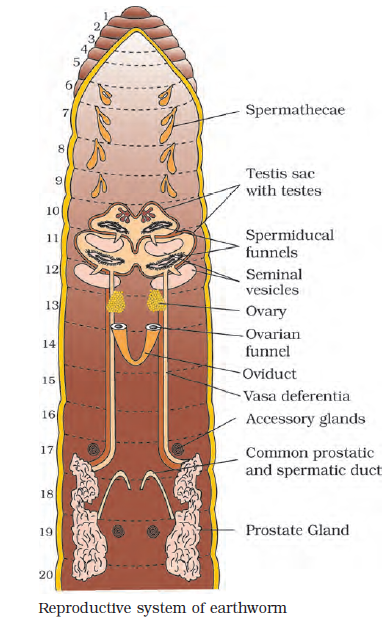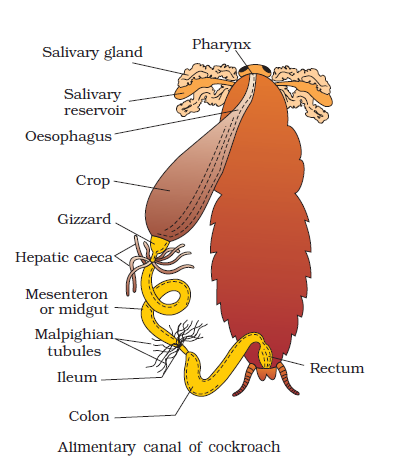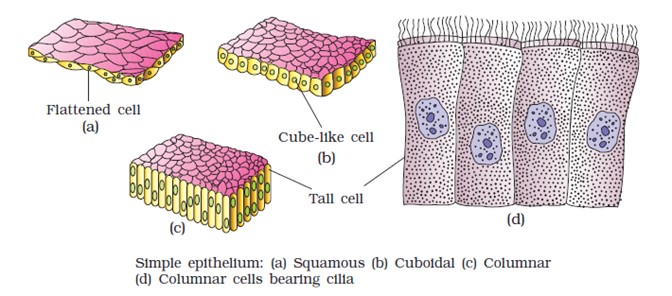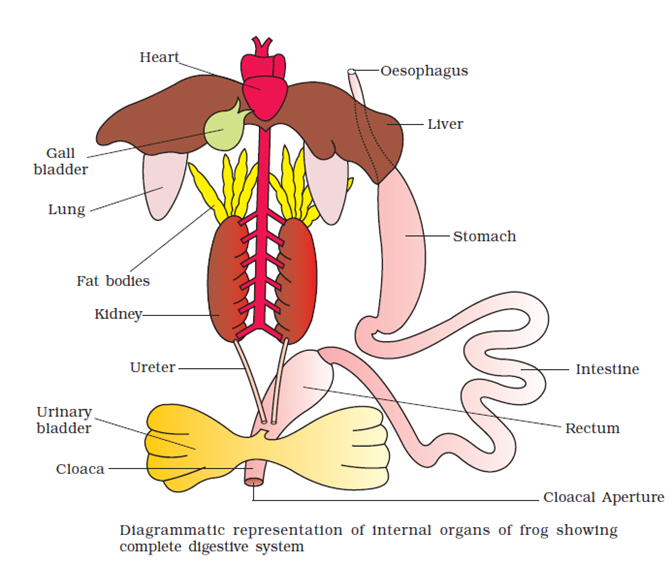CBSE 10th Date sheet 2024 CBSE 12th Date Sheet 2024
Class 11 Biology (Partnership Biology ) Chapter 7: Structural Organization in Animals - Questions and Answers of NCERT Book Solutions.
1. Answer in one word or one line.
(i) Give the common name of Periplanata americana.
(ii) How many spermathecae are found in earthworm?
(iii) What is the position of ovaries in cockroach?
(iv) How many segments are present in the abdomen of cockroach?
(v) Where do you find Malpighian tubules?
Solution:
i) American cockroach
ii) 4 pairs of spermathecae are found in earthworm
iii) Two ovaries are found lying laterally around 2nd to 6th abdominal segments.
iv) 10 segments
v) Malpighian tubules are found at the junction of midgut and the hindgut of the alimentary canals of insects.
2. Answer the following:
(i) What is the function of nephridia?
(ii) How many types of nephridia are found in earthworm based on their location?
Solution:
i) Nephridia perform the function of excretion and osmoregulation in earthworms.
ii) Three types of nephridia are found in the earthworm based on their location they are:
Septal nephridia present on both the sides of intersegmental septa of segment 15 to the last that opens into the intestine.
Integumentary nephridia are attached to the lining of the body wall of segment 3 to the last that opens on the body surface.
Pharyngeal nephridia is present as three paired tufts in the 4th, 5th and 6th segments.
3. Draw a labelled diagram of the reproductive organs of an earthworm.
Solution:
The diagram of reproductive organs of an earthworm is as follows:

4. Draw a labelled diagram of alimentary canal of a cockroach
Solution:
The diagram of alimentary canal of a cockroach is as follows:

5. Distinguish between the following:
(a) Prostomium and peristomium
(b) Septal nephridium and pharyngeal nephridium
Solution:
a) Prostomium and peristomium
The differences are as follows:
| Prostomium | Peristomium |
|---|
| Small, fleshy lobe, serves as a covering for the mouth and as a wedge to force open cracks in the soil wherein the earthworm crawls. | It is the crescentic aperture at the anterior end of the first segment of the earthworm comprising the mouth |
b) Septal nephridium and pharyngeal nephridium
| Septal nephridium | Pharyngeal nephridium |
|---|
| Found at the anterior and posterior surface of septa occurring after segment 15 in earthworm | Found in three pairs in the 4th, 5th and 6th segments located on either side of the alimentary canal |
| Excretory matter is discharged into the lumen of the alimentary canal | Excretory matter is discharged into the gut, in the pharynx or buccal cavity |
6. What are the cellular components of blood?
Solution:
The cellular components of blood are – Red blood cells (RBC), white blood cells (WBC) and platelets.
7. What are the following and where do you find them in animal body.
(a) Chondriocytes
(b) Axons
(c) Ciliated epithelium
Solution:
a) Chondriocytes are the cells of cartilage. Cartilage is present in the tip of nose, outer ear joints, between adjacent bones of the vertebral column, limbs and hands in adults. They are rounded, large and mature cells that are found occurring in clusters in the matrix of the cartilage.
b) An axon is a long slender projection of neuron or nerve cell. They are present throughout the body. They emerge from the cyton and are responsible to conduct nerve impulses away from the cell body. They terminate in a group of branches known as terminal arborisations.
c) If the columnar or cuboidal cells bear cilia on their free surface they are called ciliated epithelium. They are present in the inner surface of hollow organs like bronchioles and fallopian tubes. It comprises of fine vibratile cytoplasmic processes that are termed as cilia found on its free surface. This cilia is functional in trapping foreign substances and dust.
8. Describe various types of epithelial tissues with the help of labelled diagrams
Solution:
Epithelial tissues are found lining the body surface forming a protective surface. These cells are densely packed with very little intercellular matrix.
Various types of epithelial tissues are:
i) Simple epithelium:
It is single layer of cells which functions as a lining for body cavities, ducts, and tubes.
Based on the structural modifications of the cells, Simple epithelial cells are futher divided into 4 types:
Squamous epithelium
Simple epithelum made of single layer of flattened cell having irregular boundaries. Since their cells represent tiles of a floor, they are also referred to as pavement epithelium. They are found in the walls of blood vessels and air sacs of lungs. They are involved in excretion, protection, exchange of gases, secretion of coelomic fluid etc.
Cuboidal epithelium
Cuboidal epithelium is madeup of single layer of cube-like cells. They are commonly found in ducts of glands and tubular parts of nephrons in kidneys, and
its primary functions are secretion and absorption of gamete formation.
Columnar epithelium
The columnar epithelium is made of single layer of tall and slender cells. They are found in the lining of stomach and intestine and help in secretion and
absorption. The nuclei of these cells are elongated and found at different position. It aids in absorption and secretion.
Ciliated epithelium
If cuboidal or columnar epithelium has cilia then they are called as ciliated epithelium. They are present in the inner surface of hollow organs like
fallopian tubes and bronchioles. Their function is to move particles in specific direction.
ii) Compound epithelim
The compound epithelium a layer of two or more cells with a protective function as it does in our skin. They are thick and strong compared to the simple
epithelium as they comprise of two or more cell layers. It renders protection. They cover the dry skin surface, moist surface of the buccal cavity, inner
lining of the ducts of pancreatic ducts and salivary ducts.

9. Distinguish between
(a) Simple epithelium and compound epithelium
(b) Cardiac muscle and striated muscle
(c) Dense regular and dense irregular connective tissues
(d) Adipose and blood tissue
(e) Simple gland and compound gland
Solution:
a. Simple epithelium and compound epithelium
| "Simple epithelium | Compound epithelium |
|---|
| Composed of one layer of cells | Consisting of many layers of cells |
| They are involved in the function of absorption and secretion | They are involved in the protection |
| Present in the stomach lining and intestine | Present in the lining of the buccal cavity and pharynx. |
| Cells rest on basement membrane | Cells of the lowermost layer rest on the basement membrane |
b. Cardiac muscle and striated muscle
| Cardiac muscle | Striated muscle |
|---|
| They are involuntary in function, never gets fatigued | They are voluntary in function, hence gets fatigued sooner |
| They are found in heart | Found in triceps, limbs and biceps |
| Branched fibers | Unbranched fibers |
| Uninucleated | Multinucleated |
c. Dense regular and dense irregular connective tissues
| "Dense regular connective | Dense irregular connective tissue |
|---|
| Collagen fibres are present in rows between parallel boundless fibres | Consists of Fibroblasts having several fibers that are differently oriented |
| Regular patterns of fibers observed | Irregular patterns of fibers observed |
| They are present in tendons and ligaments | They are present in the skin |
d. Adipose and blood tissue
| Adipose tissue | Blood tissue |
|---|
| It is made of collagen fibres, fibroblasts, macrophages and adipocytes | It consists of RBC, WBC, platelets and plasma |
| It is a loose connective tissue | It is a fluid connective tissue |
| Its function is to synthesise,store and metabolise the fats | Its function is to transport food, gases, hormones and waste. |
| Present beneath the skin | Present in the blood vessels |
e. Simple gland and compound gland
| Simple gland | Compound gland |
|---|
| They contain isolated glandular cells | Contains cluster of secretory cells |
| They are unicellular | They are multicellular |
| Ex: Goblet cells of the alimentary canal | Ex: salivary glands |
10. Mark the odd one in each series:
(a) Areolar tissue; blood; neuron; tendon
(b) RBC; WBC; platelets; cartilage
(c) Exocrine; endocrine; salivary gland; ligament
(d) Maxilla; mandible; labrum; antennae
(e) Protonema; mesothorax; metathorax; coxa
Solution:
The answer is neuron because it is not a connective tissue.
The answer is cartilage because it is not part of blood.
The answer is ligament because it is connective tissue, whereas the rest are glands.
The answer is antennae because the rest other are parts of cockroach’s stomach.
The answer is Protenema because it is thread-like chain of cells found in the life cycle of moss whereas others are theparts of segments of cockroach’s leg.
11. Match the terms in column I with those in column II:
| Column I | Column II |
|---|
| (a) Compound epithelium | (i) Alimentary canal |
| (b) Compound eye | (ii) Cockroach |
| (c) Septal nephridia | (iii) Skin |
| (d) Open circulatory system | (iv) Mosaic vision |
| (e) Typhlosole | (v) Earthworm |
| (f) Osteocytes | (vi) Phallomere |
| (g) Genitalia | (vii) Bone |
Solution:
| Column I | Column II |
|---|
| "(a) Compound epithelium | (iii) Skin |
| (b) Compound eye | (iv) Mosaic vision |
| (c) Septal nephridia | (v) Earthworm |
| (d) Open circulatory system | (ii) Cockroach |
| (e) Typhlosole | (i) Alimentary canal |
| (f) Osteocytes | (vii) Bone |
| (g) Genitalia | (vi) Phallomere |
12. Mention briefly about the circulatory system of earthworm
Solution:
The earthworm has a closed circular system which comprises of blood vessels, capillaries and heart.
In earthworms, blood is confined to the heart and blood vessels as it is a closed circulatory system
Contraction keeps blood circulating in one direction.
Blood glands are present on the 4th, 5th and 6th segments. They produce blood cells, haemoglobin, that are dissolved in plasma of the blood.
Blood cells and are phagocytic.
Specilazied breathing system is absent hence the moist body surface helps in the respiratory exchange with their blood stream
13. Draw a neat diagram of digestive system of frog.
Solution:
The diagram is as below:

14. Mention the function of the following (a) Ureters in frog (b) Malpighian tubules (c) Body wall in earthworm
Solution:
Ureters in frog – Acts as urinogenital duct which carries urine and sperm in the male frog.
Malpighian tubules – Malpighian tubules are excretory organs in cockroaches.
Body wall in earthworm – Helps in movement and burrowing
Last Updated on: December 05, 2025




